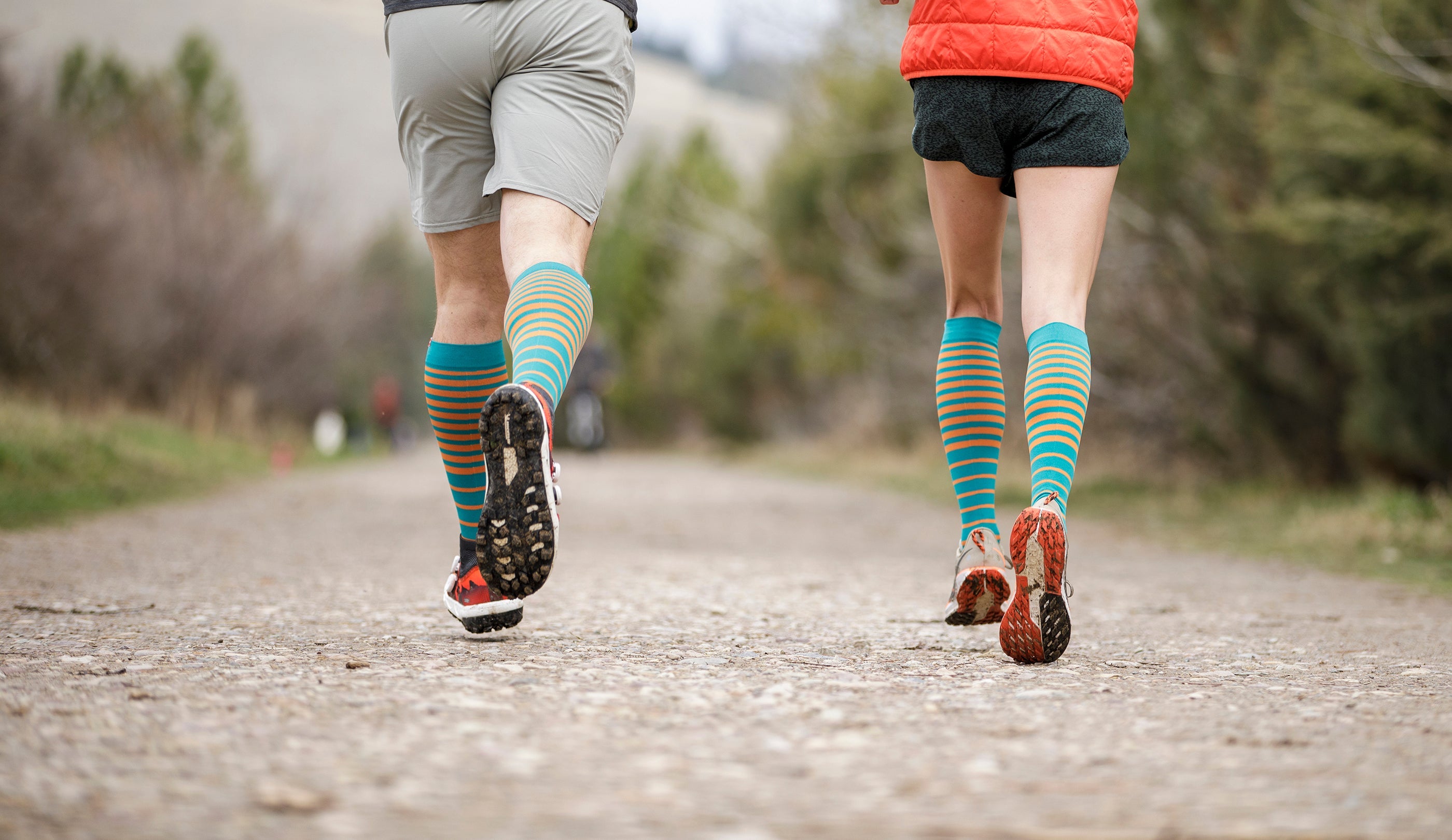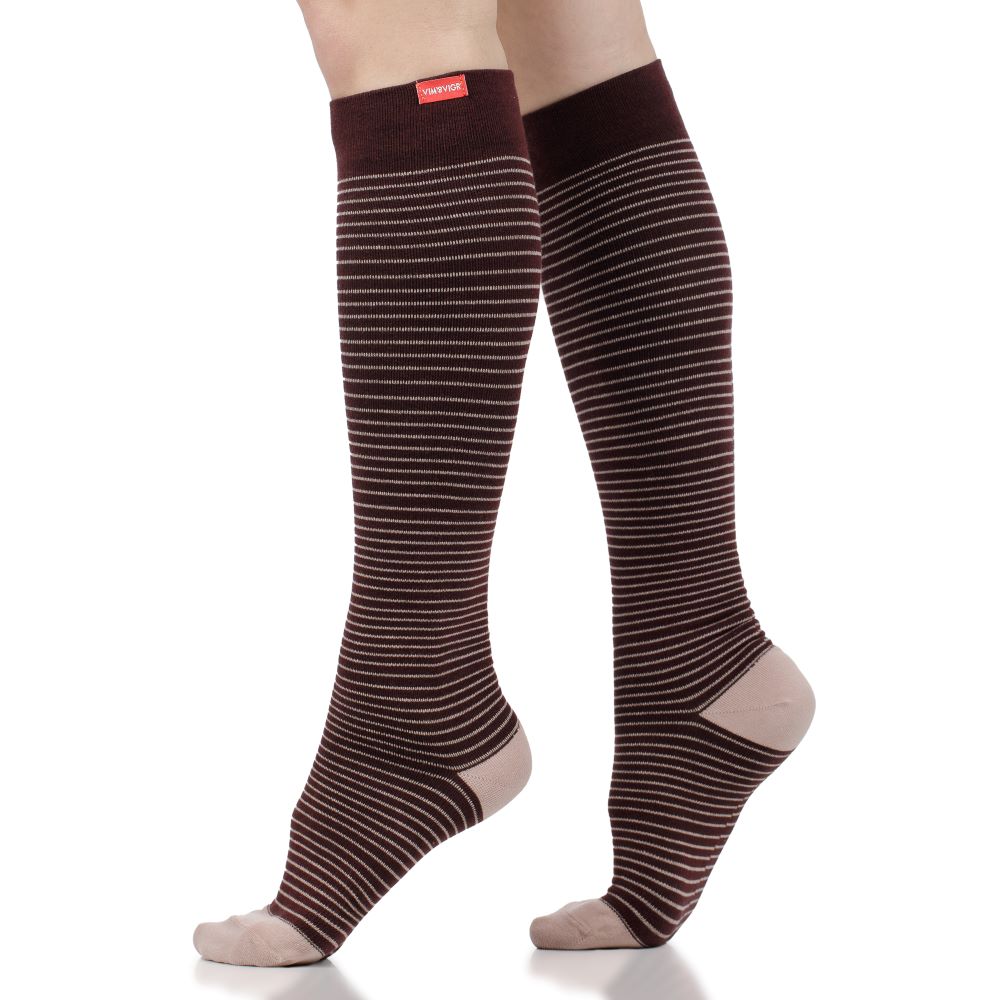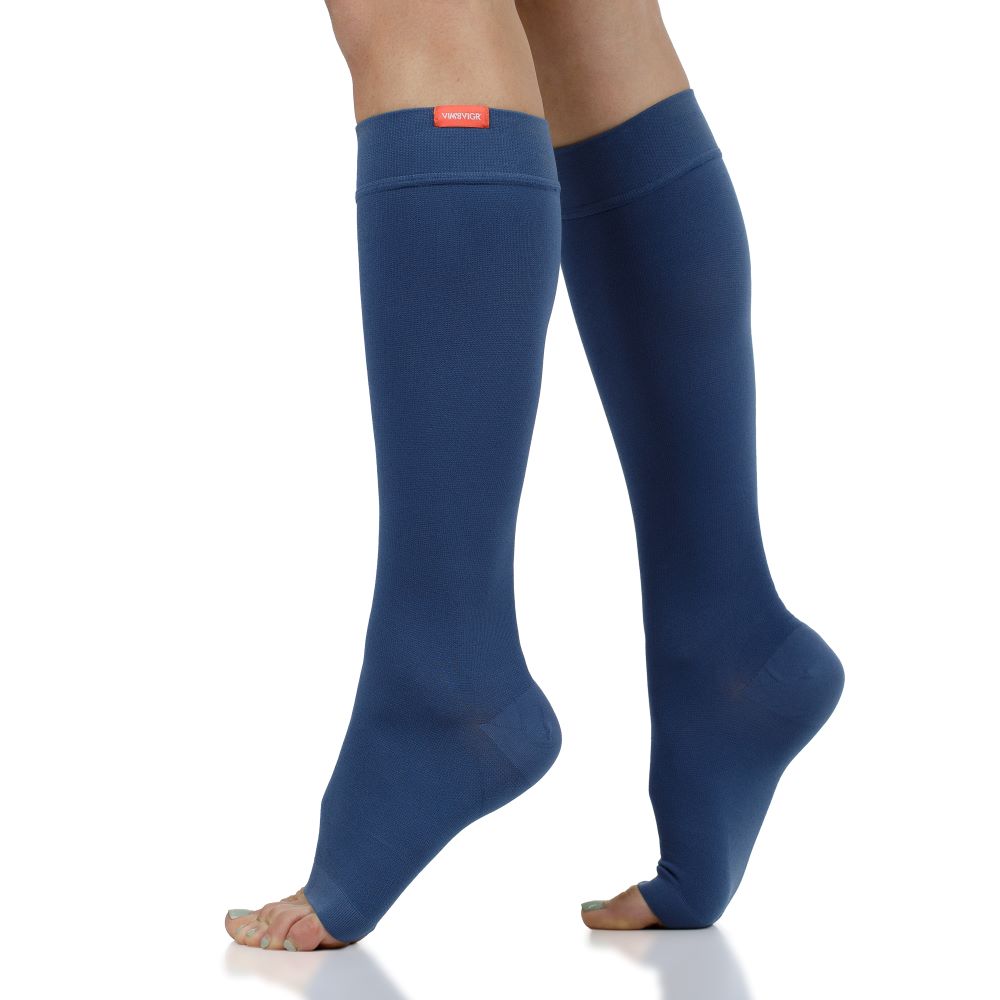What is Compression Therapy & What Are the Benefits?
When you hear the word “therapy,” do you automatically think of a highly specialized medical approach to whatever’s ailing you? It doesn’t need to be that way! In the case of compression, “therapy” refers to something as simple as wearing a lovely piece of clothing that you can get some awesome benefits from, at the same time.
So, what is compression therapy? From wearing compression socks to applying compression bandages or utilizing specialized devices, compression therapy refers to the act of applying pressure to an area of your body affected by injury.

In this article, we’ll explore:
- The benefits of compression therapy;
- The types of compression therapy and their pros and cons;
- Who it’s for (and who it’s not for!);
- How to choose the right compression garment for your situation;
- How best to use compression therapy for recovery and pain relief.
What is Compression Therapy?
We refer to compression therapy whenever a patient follows a program using compression to relieve pain and swelling. This can be caused by a number of health conditions, from an injury, to circulatory problems (like chronic venous insufficiency, blood clots, or varicose veins), to pregnancy.
Compression therapy can be done with wraps and bandages, or by wearing compression garments. These include very localized items like a sleeve or calf guard, or items that blend into an everyday outfit, such as compression stockings and socks.
Benefits of Compression Therapy
The chief reason to use compression therapy is to improve blood circulation. Whether you suffer from any insufficiency in this area, or have a related problem such as edema or varicose veins, or are looking to heal an injury or speed up recovery, compression can help you get there more easily.
Improved Blood Circulation
Conditions caused by poor blood circulation can manifest themselves in many ways, including: chronic venous insufficiency, deep vein thrombosis, leg ulcers and wounds, etc. All of these can be alleviated with compression therapy, which involves applying pressure to an affected area to stimulate blood flow.
By improving blood flow, compression supports all the healthy processes in our bodies. This leads to better recovery from injuries like sprains and strains, shortened recovery periods between hard workouts (by supporting muscle regeneration), and pain relief.
Reduced Swelling
When fluid becomes trapped in tissues in a part of your body, you’ll notice swelling. This can happen when you don’t move for long stretches of time, for example when on a long flight, or if you are bedridden as you recover from surgery. To prevent your ankles swelling, you can wear compression socks that will keep the blood flowing freely throughout your lower legs and reduce the likelihood of other issues, like lymphedema.
Improved Healing
When blood flows freely throughout the body, it delivers oxygen and nutrients to the muscles. This allows them to recover quicker after a hard effort, reducing the time it takes to get over the dreaded delayed onset muscle soreness (DOMS).
But that’s not all better blood flow will do. It can actually promote healing in the case of sprains or injuries like tendonitis. Compression therapy involves applying pressure (gently!) to the injured part of the body, getting blood to move through it and back to the heart, reducing inflammation and decreasing swelling and pain. With slightly more support for muscles and tendons from a wrap or from compression socks, you are also giving an injured limb a bit more protection while it recovers from injury.
Prevention of Blood Clots
Compression socks in particular have become part of the standard medical protocol when patients recover from surgery, with one researched benefit being that they help prevent the formation of blood clots.
This is particularly important if you suffer from deep vein thrombosis, where blood clots form in veins deep inside the body, most commonly in the legs. Wearing compression socks after surgery, during pregnancy, or during prolonged inactivity is one of the ways doctors recommend that patients avoid DVT and blood clots. In some cases, a compression boot could be a good alternative.
Pain Relief
Swelling, such as lymphedema, and discomfort from long periods of inactivity can lead to pain in the legs. Thanks to the better blood flow promoted by compression therapy, as swelling reduces, so does the associated pain that you may experience. Moreover, as compression stockings and socks exert a gentle massage on the muscles, this helps reduce soreness and pain associated with exercise.

Types of Compression Therapy
Compression socks are a very popular and accessible form of therapy, but they’re not the only option. Here are the most common types of compression therapy.
Static Compression
This refers to applying pressure to a specific area, at the same intensity. It includes applying a bandage or compression wrap to an injured part of the body. It can also include compression stockings or leggings that are equally tight throughout the body.
Intermittent Pneumatic Compression
Compression can also be applied with the aid of devices like a compression boot or compressed air devices that you can use in a medical facility or at home. These are pneumatic devices that use an air pump to create intermittent pressure for your legs.
Intermittent pneumatic compression devices can be quite expensive, but they are effective for people suffering from severe venous diseases. They have recently gained popularity as a method of recovering from exercise, too.
Graduated Compression
Finally, you can get compression benefits from garments that apply pressure to the limbs gradually. This means that the item is tighter at the end that’s furthest from the heart, becoming less tight towards it. For example, graduated compression socks are tighter around the ankles and looser as you move towards the knees.
Graduated compression is great for stimulating blood to flow back towards the heart, avoiding it pooling around the ankles and causing swelling and discomfort.

Who Should Try Compression Therapy?
Is compression therapy for you? There are several cases in which using compression garments or devices can be beneficial. And they’re not all related to a medical condition! In fact, here’s who can benefit from compression:
- People who are on their feet all day, e.g. nurses or salespeople attending a conference;
- People who don’t have the opportunity to get up and move around for a long period of time, e.g. when traveling on a long-distance flight;
- Those immobilized after surgery or during illness;
- Athletes looking to speed up recovery after hard bouts of exercise (runners in particular);
- Hikers and walkers going on long days out, looking to keep their blood flow at optimal levels;
- Pregnant women dealing with swollen ankles and feet.
In addition to these scenarios, compression therapy is appropriate after an injury and if you suffer from certain medical conditions, including chronic venous insufficiency, deep vein thrombosis, or orthostatic hypotension. In these cases, always consult with your doctor first.
Who Should Avoid Compression Therapy?
It is always a good idea to consult with a doctor before you start a new form of treatment, especially if you have concerns or a pre-existing medical condition. We particularly suggest that anyone who has a circulatory condition check with their doctor before starting to use compression therapy.
In general, you should avoid using compression if you have:
- Open sores or cuts in the area;
- Fragile, irritated skin;
- Peripheral arterial disease;
- Severe peripheral neuropathy;
- Any condition that involves lack of feeling in the area or enough disease to where the compression applied from a garment or device could impede blood flow.
Choosing the Right Compression Garment
Compression clothing is an easy, convenient, and even stylish way to apply compression therapy, especially to your legs. There’s also a lot of choice in this category!
Compression Socks and Stockings
Graduated compression socks reach just below the knee and apply more pressure to the ankles, gradually reducing as they climb up the lower limbs. They come in a variety of materials, which makes them easy to adapt to your activity levels as well.

For coverage across the whole length of the leg, stockings are a good choice. They will exert pressure on your thighs, which can be very beneficial for runners during their recovery.
Compression Sleeves
Wearing a calf sleeve gives you a more targeted form of compression therapy. This sort of garment allows you to combine it with a different type of sock or go barefoot if you prefer. Compression sleeves are also available for the arms, if that’s the area you need to target.

Compression Tights
For full coverage below the waist, compression tights are the best option. You can easily wear them with pretty much any outfit and get the benefit of compression from your toes up to your waist. Additionally, if you’re looking for something more like a pair of pants, you can opt for footless tights or compression leggings instead.

Other Methods of Compression Therapy
What about more high-tech or medically specific compression? Here are all the other options available.
Compression Boots
Boots with an air pump that allows you to increase compression to the legs through a pneumatic device are a highly specialized, expensive method of compression therapy. They’ve become more popular for athletes in recent years and are now available for at-home purchase. Depending on your medical condition, you may have access to compression boot therapy in a clinic.
Compression Bandages
These are wraps that exert pressure onto a particular part of the body. For example, bandaging an injured ankle with compression wraps can be an effective form of first aid after the injury.
Usually, compression bandages can help heal venous ulcers and can be applied by a medical professional, as well as by yourself at home.
Sequential Compression Devices
These are sleeves that inflate with air and are worn on the legs. Applying air pressure onto the legs supports blood flow towards the heart, reducing swelling in the legs as well as fluid build-up.
Lymphedema Pumps
If you suffer from lymphedema, you could use a pump every day in addition to other compression therapy items like socks or stockings. Lymphedema pumps are typically used for one hour a day on each leg, after you’ve removed compression stockings.
How to Use Compression Therapy
Before you invest in expensive devices or even buy your next pair of compression socks, it’s important to understand how best to make use of them. Here are our top tips for getting the most benefit from compression therapy.
Consistency is Key
If you are just starting out wearing compression socks after exercise, for example, you cannot expect to notice a huge difference immediately. You should plan to wear your socks after every workout and you’ll notice improvements in your recovery times, over time. The same applies to using a compression device.
Start Slowly
As with any new method or therapy, you should start using compression gradually and patiently. Those who’ve never worn compression socks before should begin at the lowest pressure level, wear them for a few hours a day, and slowly increase the time they have them on. With compression boots, the same principle applies: start with a small amount of time, then gradually increase it as and when you get comfortable.
Keep Skin Clean and Dry
One of the major side effects of wearing compression garments can be infections or irritation, but these are usually caused by pre-existing problems or lack of care for the affected area. To avoid any issues, make sure the skin is clean and dry before wearing any of these items.
Watch for Signs of Skin Irritation
In some cases, you could develop an allergic reaction or an irritation from certain fabrics in compression garments. If that happens, consult with your doctor and you may need to change the material of your compression socks.
Follow Your Doctor’s Advice
Before using compression therapy in parallel to other treatments or if you suffer from a medical condition, you should check with your doctor. They’ll also be able to advise you on how to use compression devices if one is appropriate for you.



















Leave a comment